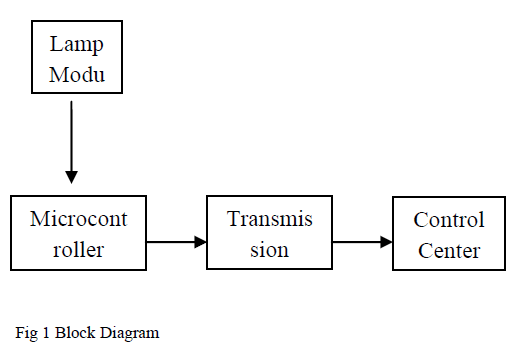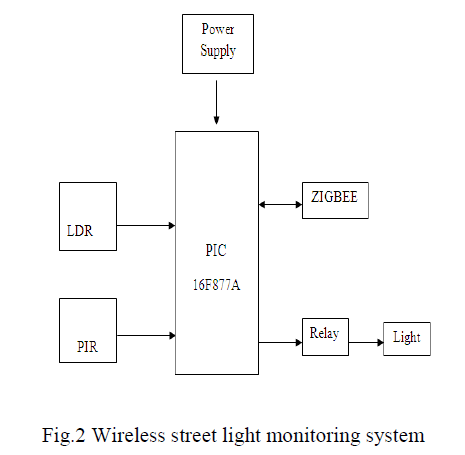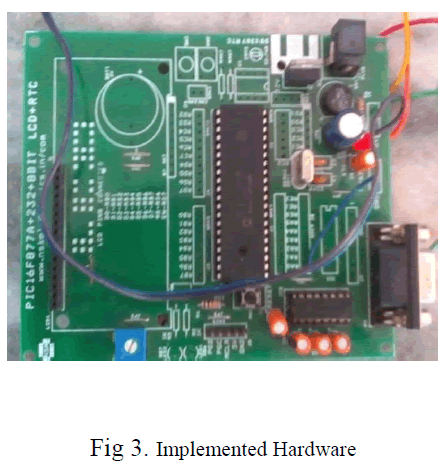ISSN ONLINE(2278-8875) PRINT (2320-3765)
ISSN ONLINE(2278-8875) PRINT (2320-3765)
Manikanda prabu.S.1, Kamal S.2
|
| Related article at Pubmed, Scholar Google |
Visit for more related articles at International Journal of Advanced Research in Electrical, Electronics and Instrumentation Engineering
The proposed remote-control system can optimize management and efficiency of street lighting systems. It uses ZigBee-based wireless devices which enable more efficient street lamp-system management, thanks to an advanced interface and control architecture. It uses a sensor combination to control and guarantee the desired system parameters; the information is transferred point by point using ZigBee transmitters and receivers and is sent to a control terminal used to check the state of the street lamps and to take appropriate measures in case of failure. Lightning systems, especially in the public sector, are still designed according to the old standards of reliability and they often do not take advantage of the latest technological developments. In many cases, this is related to the plant administrators. However, the recent increasing pressure related to the raw material costs and the greater social sensitivity to environmental issues are leading manufacturers to develop new techniques and technologies which allow significant cost savings and a greater respect for the environment. The first one, and perhaps them intuitive, is the use of new technologies for the sources of light. In this area, light-emitting diode (LED) technology is the best solution because it offers many benefits. Researchers have already considered this possibility, designing an advanced street lighting system based on LEDs. The second possible solution, and perhaps the most revolutionary, is the use of a remote-control system based on intelligent lamp posts that send information to a central control system, thus simplifying management and maintenance issues. Researchers have developed a street lamp system using the general-packet
Keywords |
| Light Dependent Resistor(LDR), Passive Infra res(PSR) |
I. INTRODUCTION |
| An embedded system is a special-purpose computer controlled electro-mechanical system in which the computer is completely encapsulated by the device it controls. The first mass-produced embedded system was the guidance computer for the Minuteman missile in 1961.The crucial design features of the Minuteman computer were that its guidance algorithm could be reprogrammed later in the program, to make the missile more accurate, and the computer could also test the missile, saving cable and connector weight. Since these early applications in the 1960s, where cost was no object, embedded systems have come down in price along with an enormous rise in processing power and functionality. By the end of the 80s, embedded systems were the norm rather than the exception for almost all electronics devices, a trend that has continued since. A precise definition of embedded systems is not easy. Simply stated, all computing systems other than general purpose computer (with monitor, keyboard, etc.) are embedded systems.“Embedded” reflects the fact that they are an integral part of the system. In many cases, their “embeddedness” may be such that their presence is far from obvious to the casual observer. System is a way of working, organizing or performing one or many tasks according to a fixed set of rules, program or plan. In other words, an arrangement in which all units assemble and work together according to a program or plan. An embedded system is a system that has software embedded into hardware, which makes a system dedicated for an application or specific part of an application or product or part of a larger system. It processes a fixed set of pre-programmed instructions to control electromechanical equipment which may be part of an even larger system (not a computer with keyboard, display, etc) distance, it is largely used even though it area and memory cost are high. |
| An embedded system is an engineering artifact involving computation that is subject to physical constraints (reaction constraints and execution constraints) arising through interactions of computational processes with the physical world. Reaction constraints originate from the behavioral requirements & specify deadlines, throughput, and jitter whereas execution constraints originate from the implementation. |
| Street light control system is a centralized system which control and monitor status of street lights installed alongside load. Lights are switched to ON/OFF by thissystem’s control command. Its local status information is also monitored by control system via communication channel. To transfer control command and status information between street light control system and remote street light control terminals which installed at each light pole, various communication media and communication protocols are using. Still it is main problem of electric power supply system, especially for street light control system because it is installed at open space and along the roadside through long distance. Every street light control system operators want to reduce maintenance costs and number of person for repair. To reduce costs and number of person, street light control systems should have high stability and can give required information when operators need information for maintenance and operation. For these reason, reliable communication path and technique that is adequate for street line control system is required. We designed new street light control system that is reliable and cost effective by using Zigbee communication system technique. For that, we surveyed characteristics of street light control systems and tried to enhance safety level |
II. SYSTEM CONFIGURATIONS |
| implement wireless street light control with less power consumption, Zigbee based control system is introduced to control the street light. Sensors are used to maintain less power consumption. Two sensors are introduced to control street light in desired manual. The block diagram of the complete smart street lamp monitoring system consists of a transmitter and a receiving section. The schematic description of the block diagram is shown below. The block diagram of the complete smart street light monitoring system is shown in fig.1. |
| 1. Lamp Module |
| 2. Microcontroller Module |
| 3. Transmission Module |
| The Lamp Module consists of the two sensors; LDR(Light Dependence Resister) and PIR (Passive Infra- Red) Sensor. The microcontroller module consists of PIC16F877A Microcontroller. PIC is a family of modified Harvard architecture microcontrollers made by Microchip Technology, derived from the PIC1650originally developed by General Instrument's Microelectronics Division. The name PIC initially referred to "Peripheral Interface Controller". PICs are popular with both industrial developers and hobbyists alike due to their low cost, wide availability, large user base, extensive collection of application notes, availability of low cost or free development tools, and serial programming (and reprogramming with flash memory) capability. |
| The advantages of using PIC microcontroller are small instruction set to learn, RISC architecture, built in oscillator with selectable speeds, easy entry level in circuit programming plus in circuit debugging and are inexpensive microcontrollers. The 16F877A is one of the most popular PIC microcontrollers and it's easy to see why it comes in a 40 pin DIP pin out and it has many internal peripherals. Microcontroller PIC16F877A is one of the PIC Micro Family microcontroller which is popular at this moment, start from beginner until all professionals. Because very easy using PIC16F877A and use flash memory technology so that can be write-erase until thousand times |
 |
III. WIRELESS MONITORING SYSTEM |
| The wireless street light monitoring system is shown in fig.2. The transmitter section consists of the power supply, LDR (Light Dependent Resistors), PIR (Passive Infrared Sensor), PIC16F877A, ZIGBEE, Relay and Light. LDR is also called as a photo resistor. A photo resistor or light dependent resistor (LDR). |
| The receiver modules of Wireless Street light control is shown below which includes power supply, ZIGBEE, PIC 16F877A Microcontroller. The solar panel is used for the power supply. A solar panel is the one which gives the autonomous power to the system. Solar panel uses light energy (photons) from the sun to generate electricity through the photovoltaic effect. If the system can stopped at anywhere because of that battery efficiency so the solar panel can maintain a system by giving autonomous power. |
 |
| Nominal voltage refers to the voltage of the battery that the module is best suited to charge. The actual voltage output of the panel changes as lighting, temperature and load conditions change, so there is never one specific voltage at which the panel operates. Nominal voltage allows users at a glance, to make sure that the panel is compatible with a given system. |
| A.ZigBee Control |
| ZigBee is a specification for a suite of high level communication protocols used to create personal area networks built from small, low-power digital radios. ZigBee is based on an IEEE 802.15 standard. Though low-powered, ZigBee devices often transmit data over longer distances by passing data through intermediate devices to reach more distant ones, creating a mesh network; i.e., a network with no centralized control or high-power transmitter/receiver able to reach all of the networked devices. The decentralized nature of such wireless ad hoc networks makes them suitable for applications where a central node can't be relied upon. a specification for a suite of high level communication protocols used to create personal area networks built from small, low-power digital radios. ZigBee is based on an IEEE 802.15 standard. Though low-powered, ZigBee devices often transmit data over longer distances by passing data through intermediate devices to reach more distant ones, creating a mesh network; i.e., a network with no centralized control or high-power transmitter/receiver able to reach all of the networked devices. The decentralized nature of such wireless ad hoc networks makes them suitable for applications where a central node can't be relied upon. networked devices. The decentralized nature of such wireless ad hoc networks makes them suitable for applications where a central node can't be relied upon. a specification for a suite of high level communication protocols used to create personal area networks built from small, low-power digital radios. ZigBee is based on an IEEE 802.15 standard. Though low-powered, ZigBee devices often transmit |
| data over longer distances by passing data through intermediate devices to reach more distant ones, creating a mesh network; i.e., a network with no centralized control or high-power transmitter/receiver able to reach all of the networked devices. The decentralized nature of such wireless ad hoc networks makes them suitable for applications where a central node can't be relied upon. |
| B. ,Power Supply (Solar Panel) |
| Power Supply is the device that transfers electric power from a source to a load using electronic circuits. Power supplies are used in many industrial and aerospace applications and also in consumer products. Some of the requirements of power supplies are small size, lightweight, low cost, and high power conversion efficiency. In addition to these, some power supplies require the following: electrical isolation between the source and load, low harmonic distortion for the input and output waveforms, and high power factor (PF) if the source is ac voltage. Some special power supplies require controlled direction of power flow. Typical application of power supplies is to convert utility's AC input power to a regulated voltage(s) required for electronic equipment. Depending on the mode of operation of power semiconductors power supply can be linear or switching. The solar panel is used for the power supply. A solar panel is the one which gives the autonomous power to the system. Solar panel uses light energy (photons) from the sun to generate electricity through the photovoltaic effect. If the system can stopped at anywhere because of that battery efficiency so the solar panel can maintain a system by giving autonomous power. Nominal voltage refers to the voltage of the battery that the module is best suited to charge. The actual voltage output of the panel changes as lighting, temperature and load conditions change, so there is never one specific voltage at which the panel operates. Nominal voltage allows users at a glance, to make sure that the panel is compatible with a given system. Solar panels are devices that convert light into electricity. A solar panel is a set of solar photovoltaic modules electrically connected and mounted on a supporting structure. |
| ZigBee is a specification for a suite of high level communication protocols used to create personal area networks built from small, low-power digital radios. ZigBee is based on an IEEE 802.15 standard. Though low-powered, ZigBee devices often transmit data over longer distances by passing data through intermediate devices to reach more distant ones, creating a mesh network; i.e., a network with no centralized control or high-power transmitter/receiver able to reach all of the networked devices |
IV. HARDWARE RESULT |
| The hardware setup is shown in fig.3 |
 |
V. CONCLUSION |
| In this paper, discussed the rationale; design of Sensor based automated light control system, which must be robust and automated in nature. It is very easy to implement on current system, low cost and durable. |
References |
|